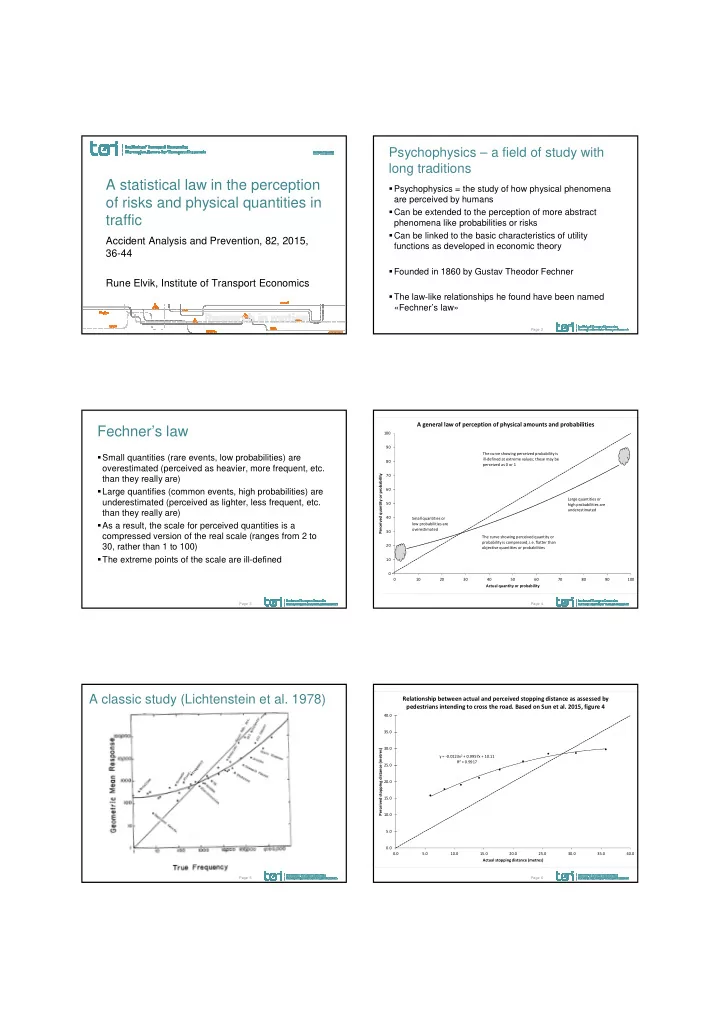

Psychophysics – a field of study with long traditions A statistical law in the perception � Psychophysics = the study of how physical phenomena are perceived by humans of risks and physical quantities in � Can be extended to the perception of more abstract traffic phenomena like probabilities or risks � Can be linked to the basic characteristics of utility Accident Analysis and Prevention, 82, 2015, functions as developed in economic theory 36-44 � Founded in 1860 by Gustav Theodor Fechner Rune Elvik, Institute of Transport Economics � The law-like relationships he found have been named «Fechner’s law» Page 2 A general law of perception of physical amounts and probabilities Fechner’s law 100 90 The curve showing perceived probability is � Small quantities (rare events, low probabilities) are ill-defined at extreme values; these may be 80 perceived as 0 or 1 overestimated (perceived as heavier, more frequent, etc. Perceived quantity or probability 70 than they really are) � Large quantifies (common events, high probabilities) are 60 Large quantities or underestimated (perceived as lighter, less frequent, etc. 50 high probabilities are underestimated than they really are) 40 Small quantities or � As a result, the scale for perceived quantities is a low probabilities are overestimated 30 compressed version of the real scale (ranges from 2 to The curve showing perceived quantity or probability is compressed, i.e. flatter than 30, rather than 1 to 100) 20 objective quantities or probabilities � The extreme points of the scale are ill-defined 10 0 0 10 20 30 40 50 60 70 80 90 100 Actual quantity or probability Page 3 Page 4 A classic study (Lichtenstein et al. 1978) Relationship between actual and perceived stopping distance as assessed by pedestrians intending to cross the road. Based on Sun et al. 2015, figure 4 40.0 35.0 30.0 Perceived stopping distance (metres) y = -0.0123x 2 + 0.9957x + 10.11 R² = 0.9917 25.0 20.0 15.0 10.0 5.0 0.0 0.0 5.0 10.0 15.0 20.0 25.0 30.0 35.0 40.0 Actual stopping distance (metres) Page 5 Page 6
Relationship between actual and perveived distance (metres) needed to Speed adjustment as a function of speed adaptation. Based on Schmidt and overtake. Based on Gordon and Mast 1968 Tiffin 1969 400.0 80 Instruction: Slow down 70 70 70 to 40 miles per hour 70 350.0 Instruction: Accelerate 60 to 40 miles per hour 300.0 Perceived distance needed (metres) y = 0.6617x + 100.45 (from standstill) 53.4 R² = 0.9002 50.5 Speed (miles per hour) 50 250.0 44.5 41.4 40 40 40 40 40 200.0 30 150.0 20 100.0 10 50.0 0 0 0 0.08 17 34 0.0 Time spent at higher speed (70 miles per hour) - minutes 0.0 50.0 100.0 150.0 200.0 250.0 300.0 350.0 400.0 Actual distance needed (metres) Initial speed Target speed Chosen speed Page 7 Page 8 Accuracy of speed adjustment as a function of duration of exposure to higher Relationship between actual and perceived speed needed to save a stated speed travel time (e.g. 50 minutes). Based on Svenson 2009 1.200 350 Accuracy of speed adjustment (1.00 = perfect adjustment) 300 1.000 Stated speed (kilometres per hour) 250 0.800 y = 0.9213e -0.016x 200 R² = 0.8847 0.600 150 y = 11.735ln(x) + 27.026 0.400 R² = 0.589 100 0.200 50 0.000 0 0.00 5.00 10.00 15.00 20.00 25.00 30.00 35.00 40.00 0 50 100 150 200 250 300 350 Duration of exposure to 70 miles/hour Actual speed (kilometres per hour) Page 9 Page 10 Relationship between actual and perceived risk of apprehension for traffic Actual and perceived increase in risk of injury accident associated with violations increased speed. Based on Svenson 2009 1000.00 500 Perceived increase in risk (percent; 400 = risk increases fourfold) 450 100.00 Perceived risk of apprehension (per 1,000 drivers) 400 350 10.00 y = 105.1e 0.0025x R² = 0.7997 300 y = 0.1116x + 5.1749 R² = 0.2738 1.00 250 200 0.10 150 100 0.01 50 0.00 0 0.00 0.01 0.10 1.00 10.00 100.00 1000.00 0 50 100 150 200 250 300 350 400 450 500 Actual risk of apprehension (per 1,000 drivers) Actual increase in risk (percent; 400 = risk increases fourfold) Page 11 Page 12
Relationship between actual and perceived fatality rate for seven modes of Relative valuation of different damages/injuries in four countries transport. Based on Elvik and Bjørnskau 2005, figure 1 1000.00 100000000 Perceived fatality rate (log scale; safest mode = 1.0) Fatal 10000000 100.00 Logarithm of monetary valuation Serious Motorcycle 1000000 Norway Great Britain Slight 100000 10.00 Cycling Germany Sweden Car Aviation Walking 10000 Damage-only y = 1.5711e 0.0217x Rail R² = 0.8194 Boat 1.00 Bus 1000 100 100 1000 10000 100000 1000000 10000000 0.10 0.10 1.00 10.00 100.00 1000.00 Logarithm of number of cases Actual fatality rate (log scale; safest mode = 1.0) Page 13 Page 14 Function fitted to data points relating income to happiness in the United States 1994-1996. Based on Frey and Stutzer (2002) 3.00 2.80 Score for happiness (1.00 = minimum; 3.00 = maximum) 2.60 2.40 2.20 y = 1.1781x 0.0636 R² = 0.9161 2.00 1.80 1.60 1.40 1.20 1.00 0 10000 20000 30000 40000 50000 60000 70000 Equivalent income per household member (US dollars) Page 15
Recommend
More recommend